William Edward Winton – bill poster, printer, photographer, impresario.
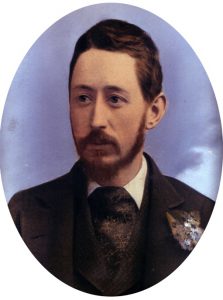
Captain Henry Roberts R.N. who sailed round the world with Captain Cook, John Brown the well known Victorian town notary and Henry Cheal the historian were all celebrated sons of Shoreham. To these names should be added William Edward Winton whose colourful life and work during the first half of the last century brought enjoyment to many Shoreham residents and, through his photos, continues to do so today.
During the late 18th and first half of the 19th centuries the name Winton often appears in the parish records of a close group of downland villages including Bramber, Beeding, Edburton, Steyning and Old Shoreham. In the latter there was a particularly large family some members of which over the ensuing years migrated into New Shoreham.
The 1851 Census returns tell us that Edward Winton came from Old Shoreham and was born about 1818, probably a member of that large family but so far it has not been possible to trace his baptism entry. In 1844 Edward married Harriett Hards, a 26 year old from Henfield who had moved to Brighton. Edward was a coke burner employed by the Shoreham Gas Company at their gasworks in Ropetackle and he and his wife moved into a house there in ‘Rapticle Street’ (at one time known as ‘Gas House Street’ and later ‘Little High Street’). It was here where the first of their children were born; Jane in 1846, Mary in 1848 and Sarah Ann in 1851. There later followed William Edward in 1852, Esther in 1854, Emily in 1856 and Cordelia in 1860.
Edward died in 1870, a relatively premature death at the age of 52 which doubtless caused some hardship for his family and necessitated their move from Ropetackle to Ship Street. Harriett was now working as a laundress to help provide for her family and also took in lodgers as an additional means of income. The eldest daughter Jane had by then married Robert Higham, a master printer in the High Street next to the Star Inn. Harriett’s eldest son William had also been taken on by Robert as a printer so that financial worries for the Wintons began to ease and also provided William with the opportunity to learn a trade that was later to enable him to start his own business.
The Highams eventually moved across the road to premises just east of the Town Hall where Robert and his sons continued their letter press printing business. William Edward Winton took over the premises by the Star Inn and moved there with his new wife Emma, nee Lower of Shoreham, whom he married in 1871. There followed the birth of no less than ten children – William Clement Adolphus In 1873, Lionel 1875, Norman Edward 1878, Ivy Winifred 1879, Stanley Howard 1882, Daisy Blanche 1883, Ralph 1884, Myrtle 1885, Guy 1888 who later died of meningitis aged ten, and Pansy in 1889.
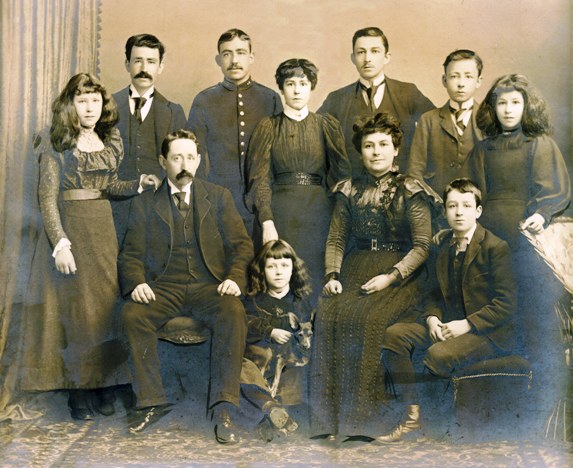
The Wintons like many at the time tended to move house quite frequently. The 1891 census shows William as a printer and bill poster at 12 East Street with his family but he also kept the shop in the High Street (subsequently numbered 14, High Street when street numbering was properly formalised). By 1901 they had moved to Stone House at Star Gap in the High Street. Sons William junior 27 and Ralph 17 are included there as a printer general and printing apprentice respectively with eighteen year old Daisy as a dressmaker. Initially, three of William’s sons joined the printing business although Stanley chose to become a plumber, Ralph emigrated to Canada and Lionel moved to Brighton a few years later.
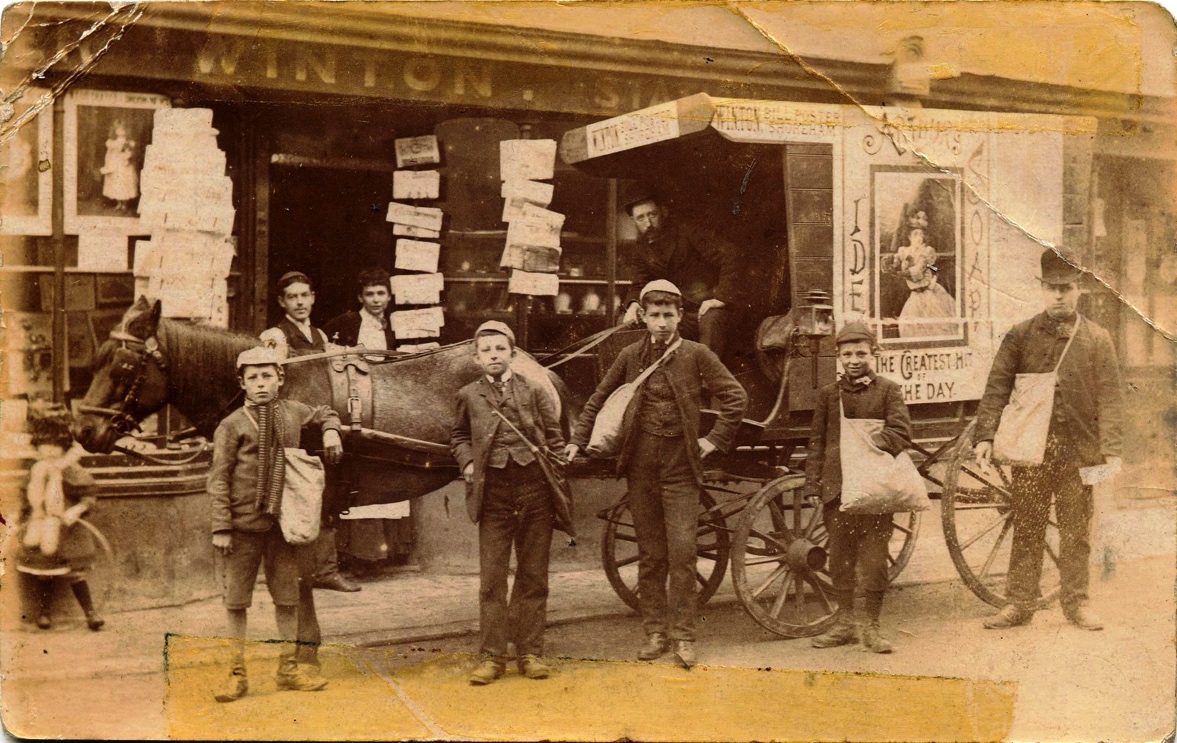
Their printing works were in part of the buildings that included Dolphin Chambers just across the road from the shop, next door to Paines the ironmongers. Naming the firm ‘William Edward Winton & Sons’ William senior soon realised at an early stage that for a printing business to thrive pictures were necessary in addition to the printed word. Photography was still in its infancy but the public wanted pictures and they sold well as postcards. In a (then) picturesque town like Shoreham with its quaint old buildings in the High Street and elsewhere there were plenty of opportunities for attractive and interesting views.
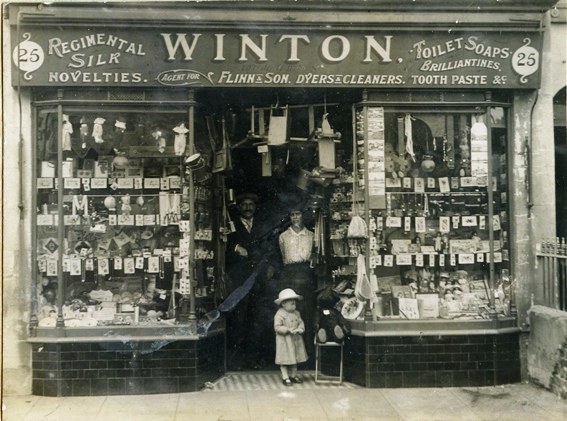
The earlier photographs in the Winton Collection suggest that William senior took them himself but he was largely involved in his bill posting business and the indications are that his son increasingly took over the photography and subsequently the printing and postcard publishing as will be seen later.
By 1907 the family had moved to 8 Church Street and in 1911 they are shown again but this time just across the street at number 9 next to the old Star Chapel which William Edward Winton had also since purchased. He used the Star Hall at first for lecture and concert hall performances. In 1908 he was granted a cinematograph licence and would show all the latest silent moving picture films there. He was probably one of the earliest motion picture photographers himself as it is said that he took moving pictures of Shoreham folk then showed them at the hall later (a ‘still’ from it still exists) – another money spinning idea to encourage people into the hall to see themselves. There is a photo of outside the cinema decked with posters and bunting on which can be seen two advertisements for forthcoming films both British; one is ‘Mr. Gilfil’s Love Story’ a film based on George Eliot’s 1857 book and the other ‘Beyond the Dreams of Avarice’ both were on general release in 1920.
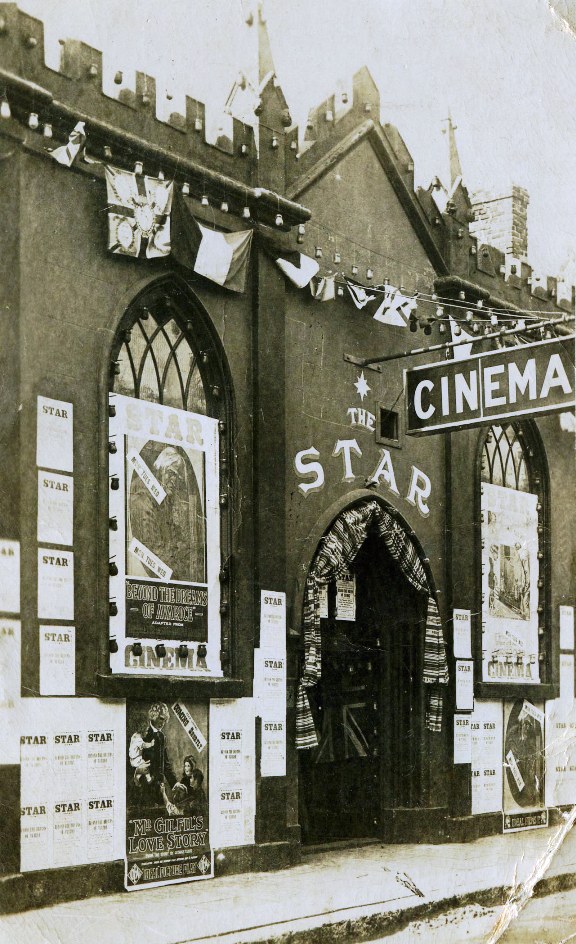
Photos of William Edward suggest a relaxed individual, often pictured with both hands in his pockets but we also know him to have been an energetic, enthusiastic and generally popular person involved in many different business ventures. His granddaughter as a child remembers him as being a granddad that was full of fun. He delighted in entertaining his friends, relatives and business colleagues at his Church Street home as shown by the numerous photos of them in his garden during their visits. He would often provide outings and excursions for his friends and employees and such was the regard for him that in 1920 well over 80 individuals subscribed to a ‘Friendship Certificate’ the list of which reads like a ‘Who’s Who’ of Shoreham at the time.
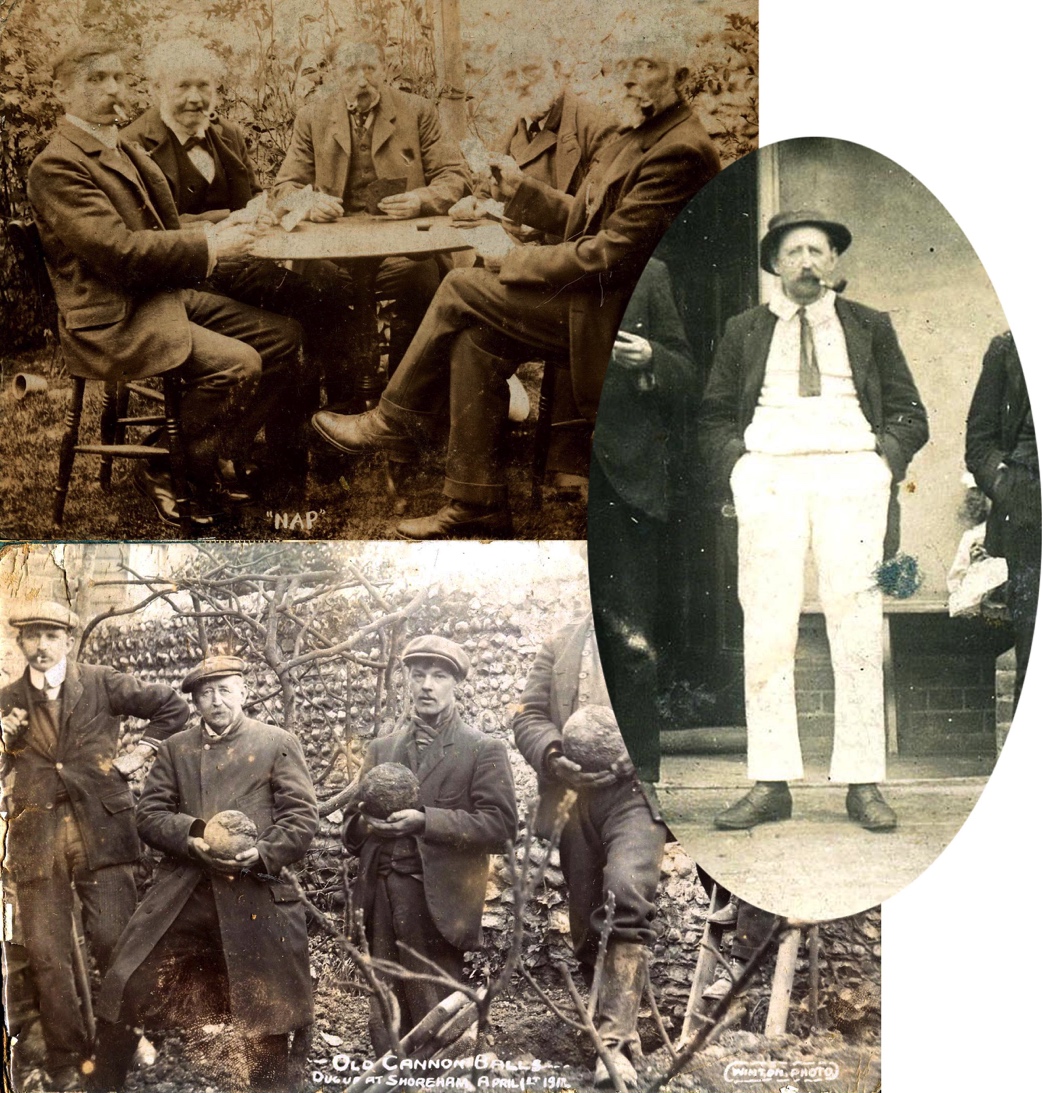
In conjunction with his son William junior, William’s businesses continued to thrive and by now included the cinema, two shops (14, High Street and now another at 25, Brunswick Road), for a while the Star Inn on the corner of Church Street with the High Street, printing and of course bill posting. However, William junior was gradually taking over more of the responsibility, particularly the printing business and this enabled his father to become increasingly involved in another venture, the setting up and organising events and functions in the town. Fetes, fairs, festivals, functions and particularly the carnivals and regattas (William had been a keen rower in his youth and often rowed in the long standing traditional town regattas for the rowing club) were all arranged by him and the first was in 1904. His regattas were carefully thought out so as to entertain everyone combining as they did comedy and sport with the picturesque and becoming so popular that they soon became known as ‘Winton’s Regattas.’
William’s family, relatives and friends were all involved in the preparations. His wife Emma is known to have been responsible for organising the decoration of the boats and other props used for the regattas, daughter Daisy made up countless costumes and the family photo album includes many photos of William’s other daughters and sons posing in fancy dress – the attic at Church Street must have been packed with these costumes.
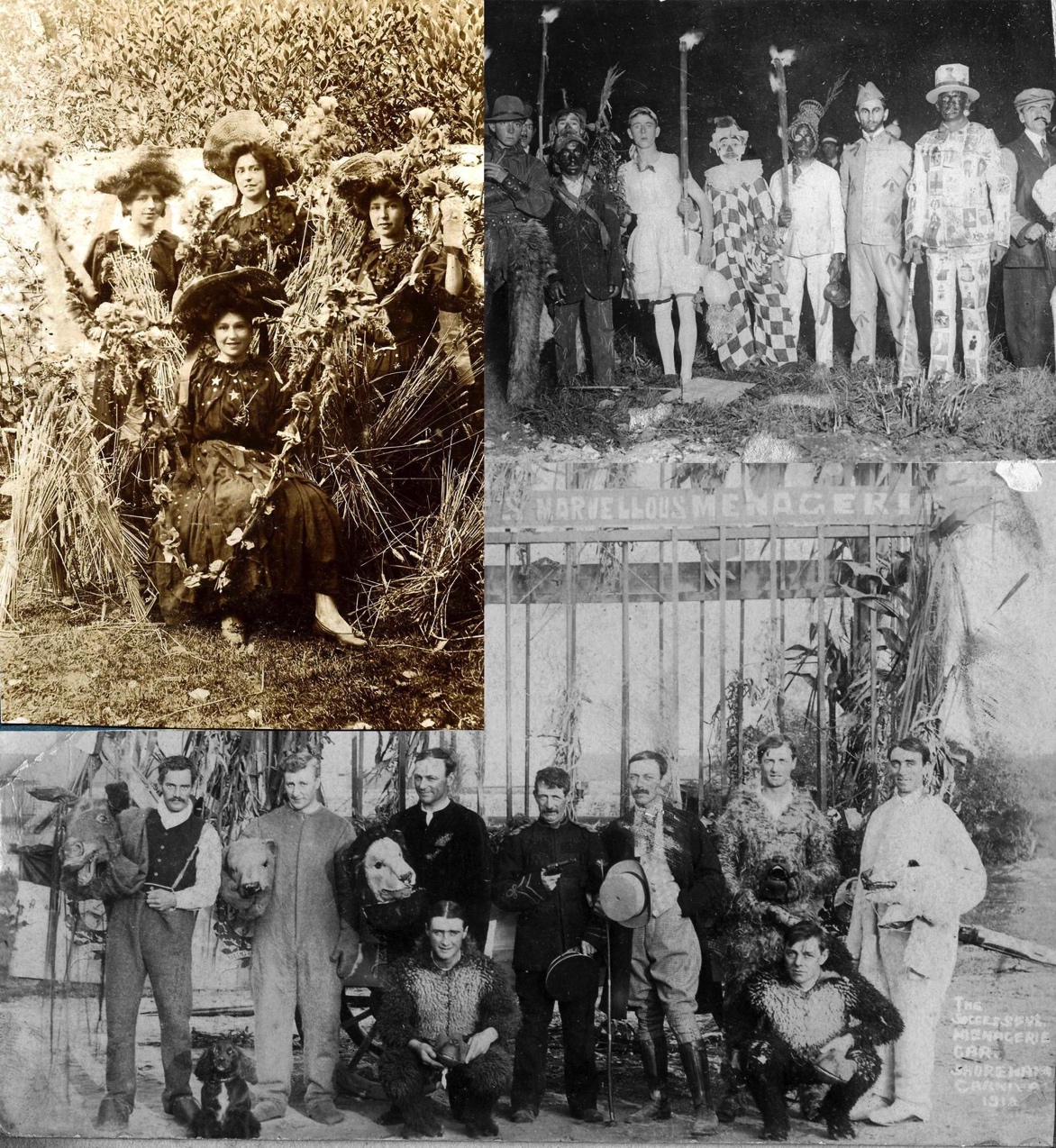
Local newspapers often covered these events and the following are extracts from reports of a 1924 event:- ‘Shoreham in Carnival Mood – Revelry by Sea and Land – It took exactly thirteen days to organise Winton’s river sports and Venetian water carnival at Shoreham this year and this must be counted a praiseworthy performance even for Mr.Winton with his quarter of a century’s experience.’ ‘…. Shoreham was set alight from dawn to dusk….’
Entertainment included a ‘Rodeo on the River’ performed by Charlie Griggs followed by boat races of all types of craft including more serious events such as sculls. Imaginative events such as shovel races (using shovels as paddles), stilt races through the water, punting races, greasy pole fights, tug of war in the mud, children’s events and even swimming races for dogs across the river. There was also a procession through the town on decorated floats headed by the Tilling’s Prize Brass Band, the inevitable fancy dress competitions and in the evening there came the grand finale when according to the newspaper reporter:- ‘…Shoreham vied with Venice with beautifully decorated and illuminated boats in procession up and down the river accompanied by music from a craft carrying the Tilling’s band.’ The whole scene was then further lit up with firework displays.
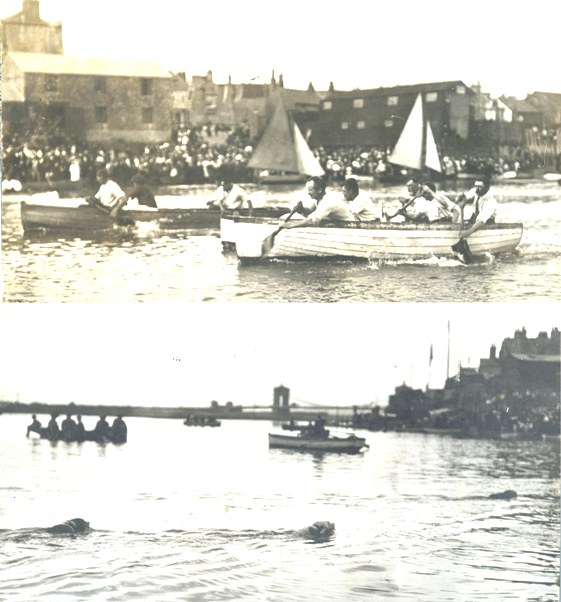
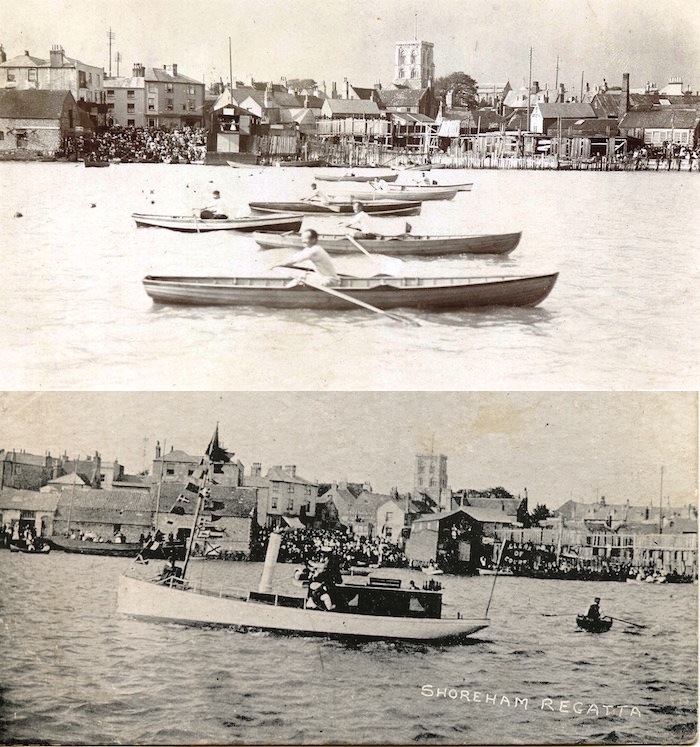
The list of competitors, prize winners, prize givers, judges and officials seemingly involved a large chunk of the town’s population and the lists include many well known Shoreham names. The town would have been thronging with residents and visitors all participating in the carnival in just the same way as people do in the Notting Hill carnivals today. Presentation of the prizes was a separate affair and in the early years carried out at Winton’s hall in Church Street then later at the Coliseum along the Brighton Road. William senior seems to have sold the Star Theatre on during the 1920’s and, although the family never owned the Coliseum, they used it in preference to the Star because it was larger, had its own changing rooms and better facilities.
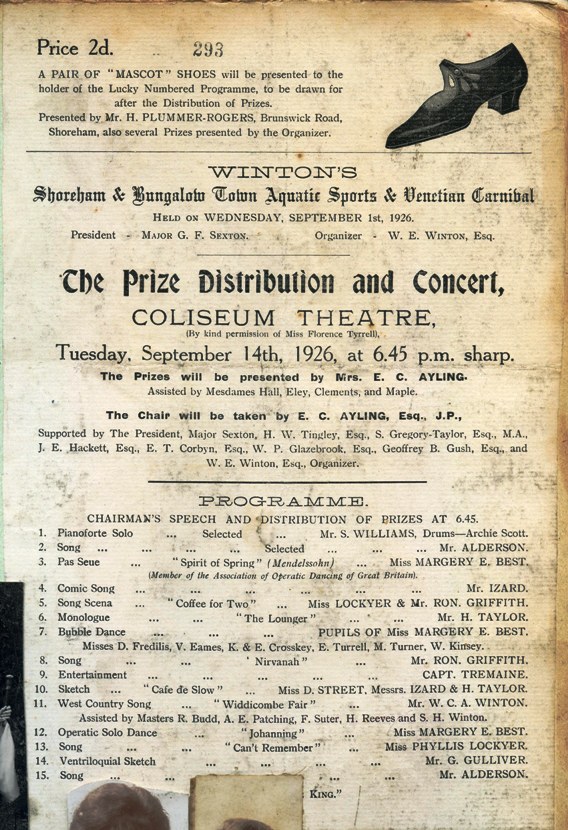
By now William Edward had retired from his bill posting business and his son had taken over the printing, photography and shops. However such was the obvious bond between father and son that William senior doubtless continued to be involved in aspects of the business right up to his death in 1932 at the age of 80. His funeral at St.Mary’s church was well attended by his sons, daughters and their families from Shoreham. As both a business man and a popular character the congregation included many names that those interested in Shoreham’s past will immediately recognise:- the Patchings (oil and hardware business), the Highams (printing), Burfoot (nurseries and market gardeners), Payne (ironmongers), Suter (yacht builders), Griggs (ship owners), White (timber merchants), Ellman Brown (estate agents) and Pope (printers). The families of Burfoot and Ellman Brown were also officers at one time or another for the town council as was William Winton junior. Lionel Winton, under the pseudonym ‘Mickey Doolan’ had also gained some reputation as the author of humorous, topical verse and it was brother Stanley who created the ‘Golden Sands’ holiday resort at Lancing using redundant Pullman coaches as accommodation.
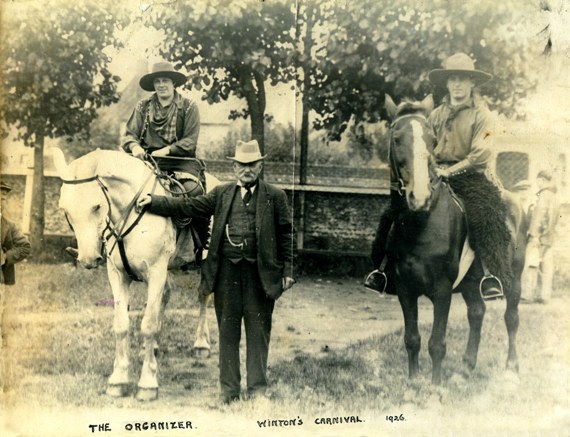
The son – William Clement Adolphus Winton
In many ways William junior was very much like his father carrying on as he did the work that his father had started. If anything he was perhaps even more of an outgoing personality and after serving his country in the Great War rejoined the business and assisted in the organisation of the carnivals and regattas. His scrap books demonstrate his passion for the theatre and musical shows and he would often travel to Brighton and London to see them as well as organising his own local presentations of the Amateur Players and Operatic Societies of which he was a prominent member and participant.
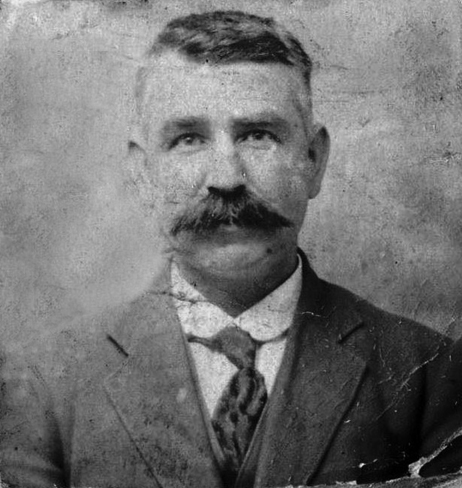
At one stage he even had a spell as landlord of the Star Inn which was next door to the shop in the High Street. It was here that his niece recalls an episode when she happened across William, who obviously had an eye for the ladies, kissing the barmaid which resulted in an angry and public slap round the face from his wife after she found out. Despite this they were a happy, loving and bustling family.
Father and son had worked together closely to begin with until around 1900 when the latter became more responsible for the printing business and was often to be seen around town with his camera taking photos which he then printed on to postcards. Certainly it was William (Bill) junior who developed the postcard business as none of the Winton cards has a postmark before 1906, and no card has an undivided back, which would prove publication in around, say, 1903.
Publication of the first cards therefore appears to coincide with Bill setting up in business on his own. Since father and son were very close, it would have been natural for Bill to re-use some of his father’s photos.
Together with other early Shoreham photographers such as William Page in East Street and Frank Rowe at 18 High Street just along the road from the Winton’s shop, Bill took many pictures not just of local views but of people in the town, events and particularly the pioneering flying days of aircraft and air displays at Shoreham soon after the airport opened in 1910. He was also one of the first to photograph the town from St.Mary’s church tower and made a point of always keeping aware of what was happening around him in order to capture on film such events as the aftermath of the fire that destroyed the original Sussex Pad in 1905 and the storms of 1912 and 1913 – the more newsworthy of these photos were sold to local newspapers as well as being made into postcards.
At age 43 during the Great War William junior enrolled with the 4th Battalion of the Royal Sussex Regiment Volunteers in 1916 but was only given a grade III at his medical probably because he was over the upper 41 years age limit. As with others of his age and above he was therefore most likely restricted to local defence duties although there are a few original photographs (not newspaper cuttings) in the family album of a devastated Belgian or French village, a British tank, a Zeppelin airship and one of the King and the Duke of Connaught inspecting troops at Hyde Park but they appear to be fairly well known images of the time.
With a ready eye for opportunity he soon realised there was a profit to be made by photographing the massive military camp behind the town during 1914/18 when large numbers of his cards were bought and sent home by British and Canadian soldiers from the shop that he set up in a hut on the camp.
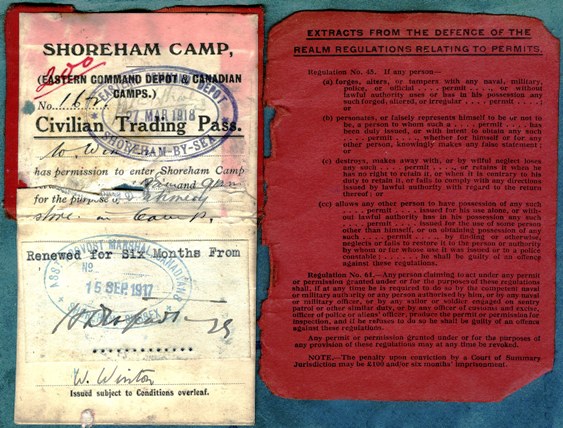
Bill’s early cards can be readily recognised by the descriptions of the scenes that he scratched on to the negatives together with the distinctive brand or logo of the name ‘Winton’ or ‘Winton Photo.’ This logo was surrounded by a stylised circle of continuous or separated lines as illustrated in the following selection of cards.
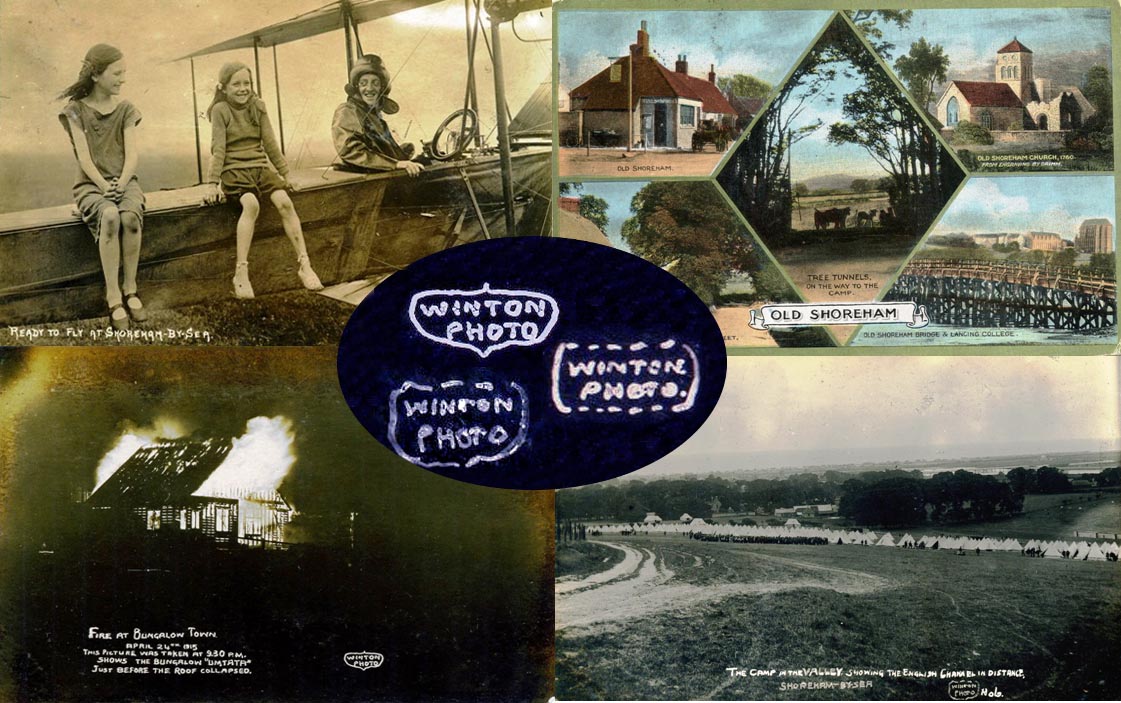
The demands upon their printing business eventually necessitated larger premises and during the 1930’s the Wintons acquired the building behind Marlipins in Middle Street (now rebuilt as the museum annexe) for its printing works. In addition to the photography Bill was also a talented cartoonist and included a number of these in the many postcards he produced. One brainchild of his was the novel ‘Tourist’s View Pad’ which was a pad of shaped letter paper that included photos of Shoreham views and folded down into an envelope much like the air mail letter paper of more recent years.
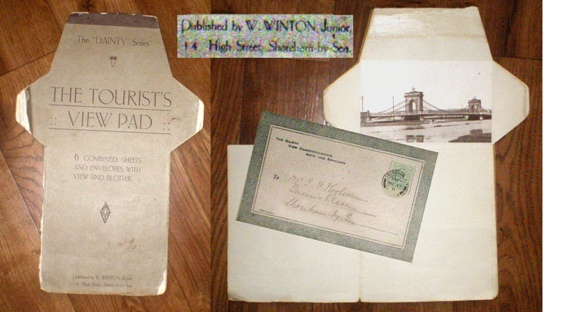
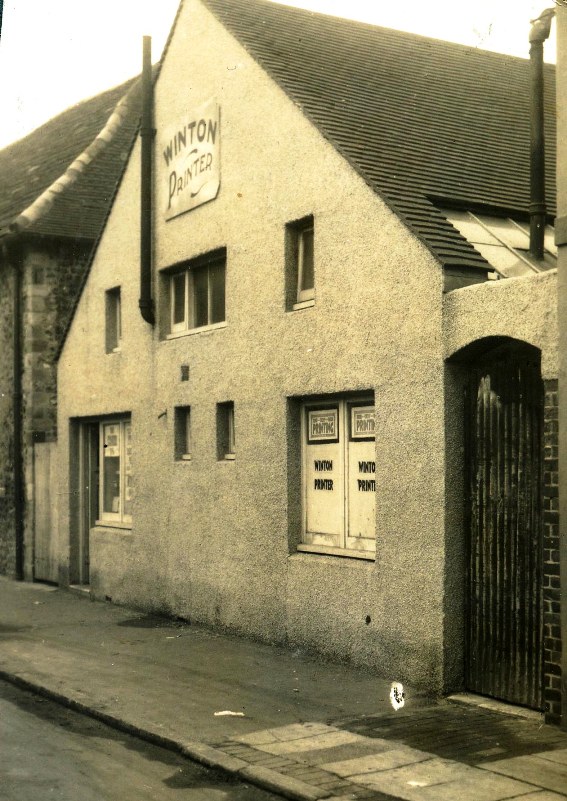
During the late 1930’s Bill had suffered some illness but by 1938 had recovered enough of his chirpiness to impress a local newspaper reporter who, in describing some Shoreham characters, writes of him:-
“There is only one way to disturb Mr ‘Bill’ Winton, rotund cherry-cheeked printer, now in fine new premises in Middle Street. That is to interrupt one of his famous stories.
Mr. Winton, Shoreham born, can spin happy tales of the town for hours. The size of his audience increases and decreases for as one customer leaves another comes sauntering through the always open door of his shop.
‘Going into Bill Winton’s’ is as much part of one’s day at Shoreham as cleaning one’s teeth – and what memories he has. It was his father who ran the famous regatta carnivals ‘on land and sea’ and Mr. Winton ever since has been bound up closely with the life of the town. Everyone is glad he has been restored to health.’
Sadly however his good health was not to last and just three years later Bill died in Shoreham at the age of 68.
It is thanks to the efforts of early photographers such as William Edward Winton, his son, William Page and Frank Rowe that historic images of our town were recorded. Views, people and events that are now no more. That we are now fortunate enough to have so many surviving postcards of these images is partly due to the enthusiasm of present day collectors but more particularly to William Winton and his son who, of all their peers and competitors, produced the considerable majority of the Shoreham postcards in the first place.
Roger Bateman
November 2009 (updated June 2011)
– with special thanks to June Stirling, granddaughter of William Edward Winton, for her kindness in providing the photos for this article from the Winton family photo albums and scrap books.
– photos of the Winton Tourist’s View pad from the collection of Peggy Bailey
N.B:-The complete collection of images from the Winton family album and scrapbooks are in themselves a valuable record of Shoreham’s history and are included for viewing on the shorehambysea.com web site.



One Reply to “William Edward Winton”